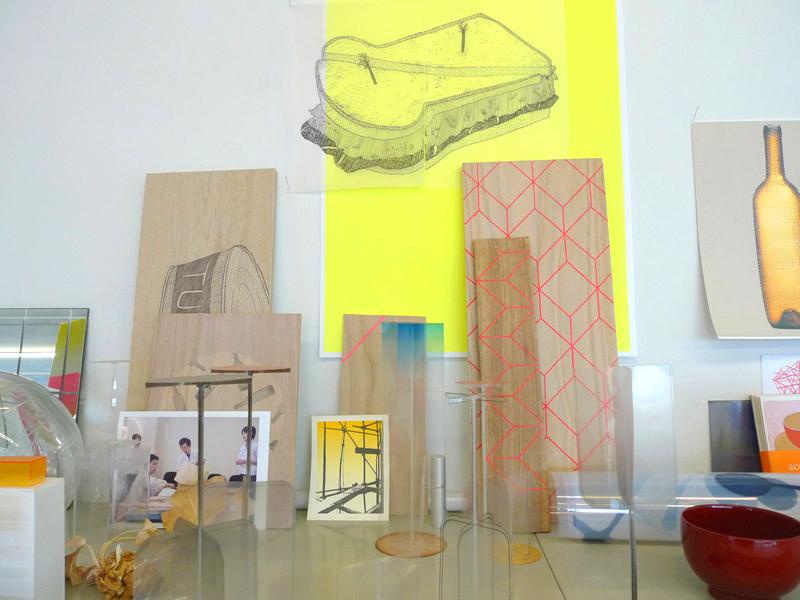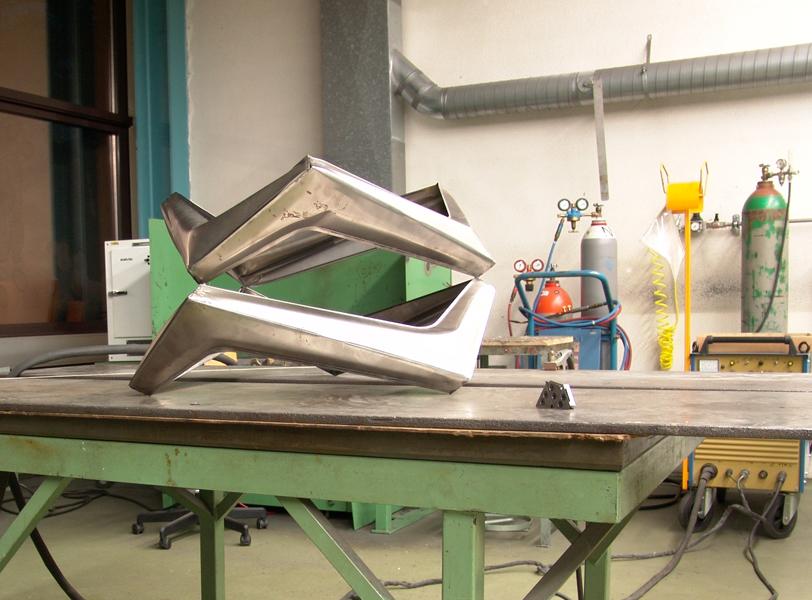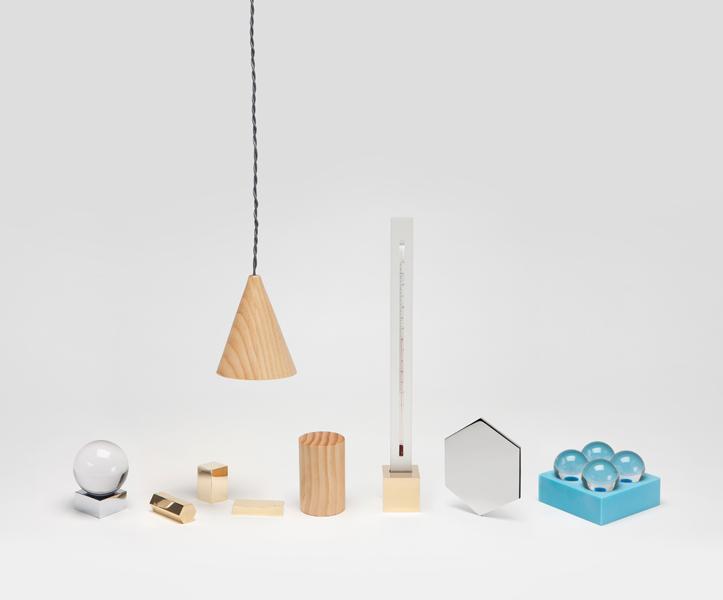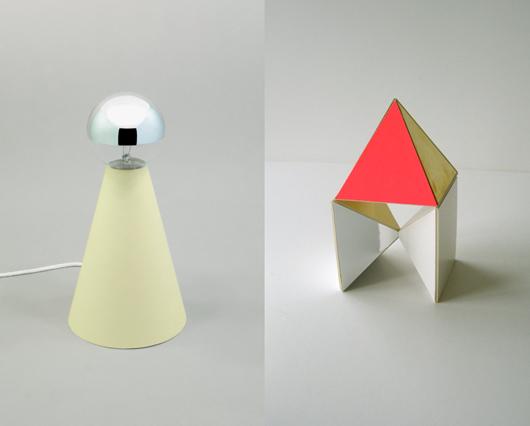
07.25.11
Q+A
Lukas and Oskar Peet, Product Designers
There’s a reason why one of the first questions we always ask Sight Unseen subjects is “What did your parents do?” In the nearly two years we’ve been producing this site, it’s become apparent that the ideas and habits of ultra-creative people usually germinate in childhood, and that the environments in which they were raised tend to have played a part — whether their formative years resembled those of Kiki van Eijk, whose father competed on the 1976 Dutch Olympic field hockey team but also taught her to paint, or Lauren Kovin, whose parents filled the house with Ettore Sottsass furniture. The more designers and artists in a given family, the more interesting things tend to get, which is why we decided to start this new Related column. In it, we’ll periodically ask creative talents who are related to interview one another about their respective practices and what it was like growing up in close proximity. First up are brothers Lukas Peet, 24, and Oskar Peet, 27, up-and-coming designers who were born and raised in the Canadian mountain resort town of Banff, attended the Design Academy Eindhoven together, and whose Dutch-born father Rudi Peet immigrated to Banff in 1974 and has since established himself as a successful jewelry designer there.
Lukas returned to Banff shortly after he graduated from Eindhoven and relocated to Vancouver two months ago, where he’s set up his own studio designing stunning geometric lights and elemental wall clocks, continually searching for ways to incorporate the influence of his Canadian surroundings into his work. Oskar, on the other hand, stayed in Eindhoven, where he works as a designer in the office of Scholten & Baijings. He’s spent the past year exploring how he can create products of his own that are concerned more with innovation than with pure aesthetic appeal, breaking from how he always viewed his father’s oeuvre. In the interview below, the siblings discuss everything from their differing outlooks on design to shared memories of curling, gun clubs, and other delights peculiar to having grown up in a Canadian idyll.
Lukas: I remember us going to our father’s studio after school, and in those couple hours we would usually draw or make things. We made some things in silver at one point.
Oskar: He had his home studio set up in the attic, and we used to play with the wax from his jewelry molds. We would make little creations out of it, and then he would grab a couple once in awhile and turn them into a piece. But when we were young, Lukas, you were always known as the more artistic one. I never actually took art in school — I saw myself as being different from you at the time. It wasn’t until the last couple of years of high school that I also became interested in artistic things.
Lukas: You’re still more analytical and thinking and calculated. My idea of the difference between us in school is that I would dive in and start making things and trying things out, whereas you would take two thirds of the time thinking first.
Oskar: When I finished high school I ended up at SAIT for mechanical engineering, which came out of dad’s love of cars and motorcycles I think. After building and fixing so many of them with him, I wanted to learn how to make machines. My going to the Design Academy started with wanting to extend my education in engineering. Rudi was at the Dutch Consulate renewing his passport and saw a brochure for English-speaking schools in the Netherlands, so that’s where the idea first came from. Because we’re three years apart, you were just about to finish high school.
Lukas: I wanted to do something with design, but you started first. Then when you came back after the first summer, I finished high school and we both went. I also had an interest in engineering and mechanical things, but not to the extent of wanting to go to school specifically for that like you did.
Oskar: How did you experience the Academy?
Lukas: I thought it was interesting the first year, because I was going straight from an academic high school to learning the design process, and of course adjusting to a new country. Being a year ahead, you were also figuring these things out too, of course, but I think we had to find our own way of working. You did a project on jewelry, and one of my graduation pieces was cutlery — which dad also made — but our designs were executed completely differently. I think that summed up the differences between us, too.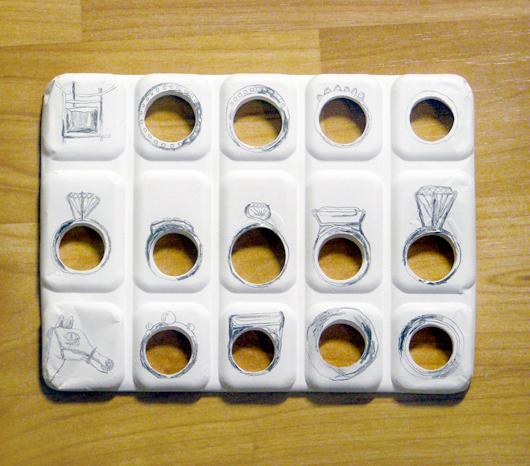
A selection from Oskar’s conceptual jewelry project at the Design Academy Eindhoven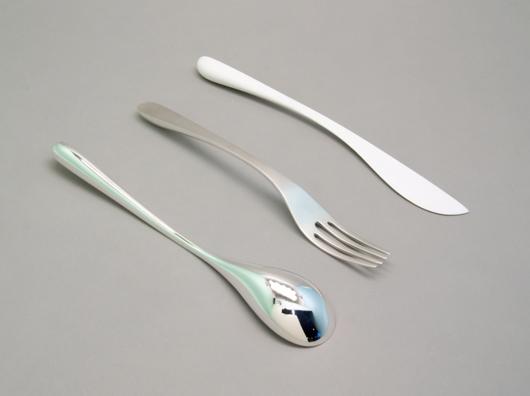
Lukas’s cutlery featured sinuous, tactile handles “hanging” from the functional tool
Oskar: The assignment was to make jewelry, and I tried to approach it like dad approaches it. He makes things for their aesthetics — they have to look beautiful, there’s not much more concept beyond that, except for their need to fit the human body. I tried to approach that project the same way, but I quickly realized I wasn’t able to make something that was just beautiful. I ended up using what others in the class didn’t have, and that was insider information: I’d spent countless hours watching my father work and learning how his creations come to life, and that process was almost as dazzling to me as the final result. I went to work depicting the steps from wax models to polishing as accurately as possible, but with a certain humor as well. The illustrations are drawn directly onto containers I cast in plaster (a material used by my father in his process), so each one had to be made in a single go. They gave me more to hold onto in terms of a concept, which I need in order to justify making something. I had of course tried to envision myself learning the tricks of the trade from my father in order to one day take over his business, but there’s something about the scale of that work in combination with that lack of a deeper concept that makes it unappealing to me.
Lukas: When I was making my silver cutlery, on the other hand, I just took blocks of wood and translated the idea in my head to the shape in my hands. It was a process of making as many models as I could until I was happy with each one and they all worked together as a group. It still began with the function of cutlery, but in the end achieved something that was aesthetically pleasing.
Oskar: But where did the idea come from?
Lukas: I think it came from the fact that cutlery is a tool, like a hammer is a tool, but it’s also pretty intimate; you use it with your mouth and your hands, so in that sense it needed a human quality. That led to combining the tool part at the top — the graphical precise part — with the human part, which is the handle that hangs from the shape.
Oskar: I know you gave the design to Rudi to fabricate, and him being such a creative force, you two had some head-butting. He had to constrain himself in order not to change your original design.
Lukas: He made the fork and spoon, and we discussed over Skype, why did you do this? Why not this? But at that point my design was final. There’s definitely a conflict in having three designers in one family where everyone has their own opinion about things. For him it was hard to make someone else’s work, even mine, because of it. All of the other projects we’ve worked on and talked about, he always has a very strong opinion.
Oskar: Do you think the idea that Rudi was so adamant about staying in Canada had anything to do with your moving back?
Lukas: Not directly, no. When I left for Europe my intention was always to move back. I spent 18 years here and grew up here, and all the things I’ve done here made me who I am. The four years I spent in Europe sort of taught me how to use them, but I wanted to bring that knowledge back to North America. Of course I like the nature and the space as well, but I also like being out of the spotlight. Europe is great, but maybe I just like having my time to myself. The main thing is I feel I’m more Canadian or North American, and I don’t necessarily want to conform to European design. I hope to take what I learned in school and apply it to inspirations I find locally.
Oskar: It’s funny, at first a lot of things you were making in Canada were maybe too sharp, too European, too minimal for the market. So maybe you have to work more on a Canadian way of thinking, which is more in basic materials like wood and stone.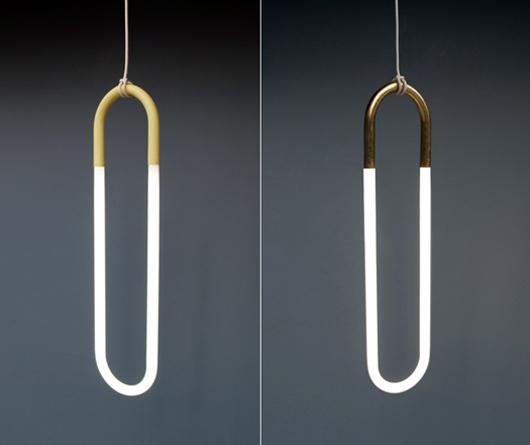
Lukas’s Hanging Lights, with either a yellow or 24-karat gold finish
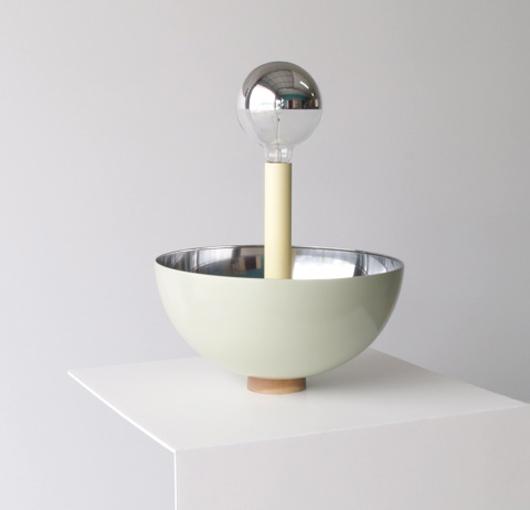
Lukas’s highly graphical Specular Table Light
Lukas: My market will probably never be in Canada, so my work does still need an international outlook. I think it is a good idea to think possibly more “North American” — I’ve been focusing on natural materials and have been trying to incorporate more traditional North American craft and technique into some of the new objects I’ve been working on. But I also like the fact that me being here allows me to see things other designers maybe haven’t seen, and will influence my work in a different way than being with everyone else in Europe. Finding a balance between the two is really the direction I’m heading in.
Oskar: But a lot of those things you saw as a child. Do you look at them differently now than you did before the Academy?
Lukas: Definitely. Before I was just looking at things, and now I look at them knowing I might make something. You always liked Europe more anyway. I remember you went there on holiday when you were 18.
Oskar: Yeah, between 11th and 12th grade, because Rudi wanted me to continue school immediately after I graduated high school, so I had that summer as the chance to take a trip. He sent me to visit our aunt and uncle in Holland. Once I was at the Academy I seemed to click with Europe, I don’t know what it is. I was always so inspired by all the things we didn’t have in Canada — I remember taking far too many pictures of cars that didn’t exist over there, which is silly now that you think back, but…
Lukas: Well, you were 17. But we also grew up in a small town in the mountains, which is very different than if we’d grown up in Vancouver or Montreal.
Oskar: The difficult part is that we considered each other best friends, because we really only had each other as children. But I had much better friends in Holland than I ever had in Canada, people who related to me, with the same interests. Whereas you always had the idea you were going back, so that made you more reserved in how you approached the people here.
Lukas: I didn’t give it a fair chance I guess. I know I could be happy there, but maybe the same way that you like all the things you can only do there, I like the things I can only do here, including the ease of being able to escape to the outdoors.
Oskar: For me I have my memories of Canada that I can draw upon. It’s more of a struggle to justify going back for the nature, because I know there’s a lot more I would be missing. Like right now I’m sitting in my studio in a whole building filled with Design Academy graduates, and I can easily go to a person down the hall and say do you have this material, or can you help me with my taxes, or my website. I have an exhibition coming up in Dutch Design Week just because of where I’m sitting. Don’t you even miss the museums, and the culture?
Lukas: That’s why I want to live in a larger city rather than in the forest. But it’s comforting for me to be here. You know the language, you know how things work.What do you miss from here?
Oskar: The fresh air, the crispness. And the fact that here you can do a lot, but in Canada you can hop on a dirtbike if you want to, or brand cattle, or be a member of a gun club. I miss hunting, I miss being able to say yeah, a bear was in the yard the other day. It was nice that we had a childhood full of being able to build forts, and go skiing, and curling. You have in Holland but you’re not as easily confronted with it.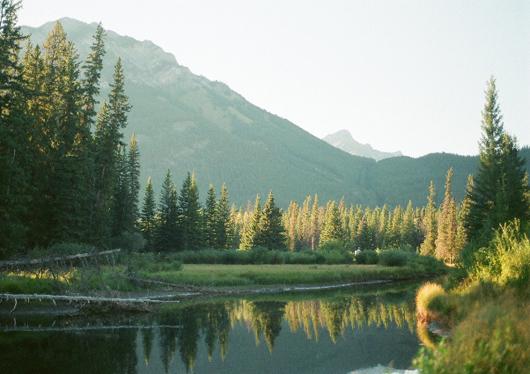
Scenes from Banff, Alberta — the Peets’ hometown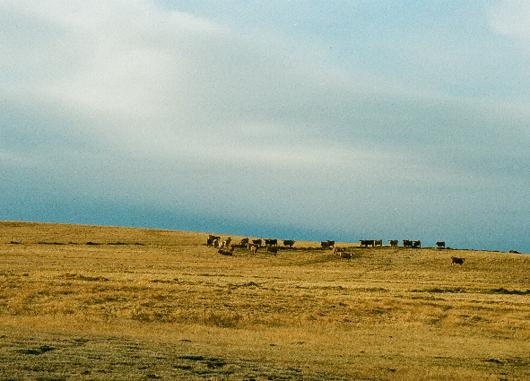
Lukas: Maybe somehow that ability to do so many activities translates into our having so many different interests now. And Dad’s love of cameras, motorcycles, cars, and all these different things. He was always interested in quality objects and quality things. The most interesting motorcycle or car, even as far as having to have the most interesting shotgun — the design shotgun. We had that Bultaco, the Spanish motorcycle, then all the audio equipment and Leica cameras. It was never the normal thing we’d get.
Oskar: In the context of the mountains, it was unusual, because all that stuff came from Europe. Rudi was always trying to do different from the way the neighbors did it.I think we somehow related to all of dad’s interests subconsciously and then later on realized why we loved objects the way we did.
Lukas: But when you combine that with going hunting, all these activities most of our friends have never done, in a way we’re really Canadian, stereotypically. But we also feel a bit more European I guess because of our parents.
Oskar: I think the reason we did a lot of these things is that Rudi didn’t have access to them growing up, so he wanted to show them to us. He moved to Canada specifically because it was, for him, a vast inspiration, but he also just always wanted to play cowboys and Indians — when he first got there he bought himself a gun and a big truck and was always looking for adventure. Anyway, how do you feel now that you’ve finished school and are on your own in Vancouver?
Lukas: It’s good. Maybe I like being on my own and doing my own thing rather than having to be amongst all these designers and creative people, who are always caught up in it. I’d rather be on the outside looking in. I think it would be more interesting to be able to make things for companies and every once in awhile go to these big events and show them, then escape back here and do my own thing. That’s how I ideally would like to work. You’re just starting to make a few of your own things now, how are you finding it?
Oskar: I’ve had this realization that I didn’t want to be this independent superstar everyone thinks they have to be after school. Sometimes I think, why should I take this table or chair so seriously, because so many already exist? I’m struggling to figure out why. I design tables chairs and products for Scholten and Baijings all day, and then I see how Stefan has to get them on the market. We spend so much time submitting these designs to companies, and you see how much work it takes before anyone takes you seriously. At the end of the day you have another stool or another lamp. That’s the biggest difference between you and I: You’re still content making products, and I think I’m going to have to venture into a different field. My girlfriend, Sophie Mensen, and I are busying ourselves making a platform to showcase what already exists. Work is going to keep being produced by students at schools and I’d like to be promoting that work. I’m very inspired by old design pieces, and collecting, and I think I’d like to be able to combine all these interests and try to stick them into one room together. Are you shocked by my change in opinion?
Lukas: No, I think it’s a good idea, and I think it suits you as a person.
Oskar: What do you think about when you approach yet another lamp?
Lukas: I agree that we don’t need more stuff, but maybe I’m selfish in that I think I have something more to say or do. And I just like making things, so if someone else likes it too, then that’s great. If it can be more clever or a better material, and a smarter product, then it’s not just some wasteful thing.
Oskar: I still like making things, don’t get me wrong. I recently made a butter dish that allows you to keep butter at room temperature. It’s based on an old technique that’s dropped off; it’s something where there’s an opportunity to say here is an improvement, and to me that’s more of a step forward than making just another table or chair for the sake of making a table or chair. That’s the first product with my new philosophy. Granted I have been asked to do something for the Dutch Design Week in October, and I’m going to make a light together with my girlfriend. We want to look at light in a totally new way, approaching it like we see the sun: as a continuous point of light that we can only manipulate by putting something between us and the sun itself, without any dimmer switch or off button. I’m searching for ways to do something new, even though it seems everything’s been done before. Just looking at it in a new way for me is refreshing enough. I still reflect on graduation projects like my Color Research, and they’re purely aesthetic, so I can only look to them as a study. I see no practical use for them as they sit now, but they still contain a lot of the things I hope to show or achieve, and they remain a constant source of inspiration.
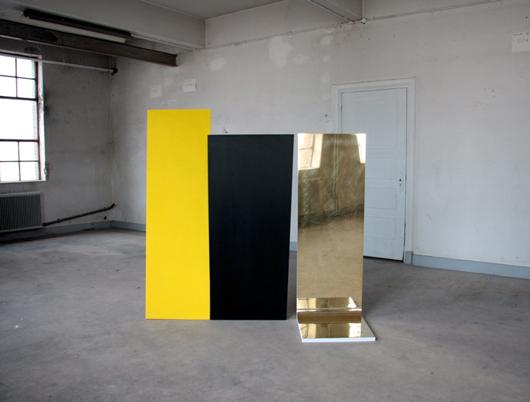
Oskar’s 2009 Room Dividers, which served as his graduation project at the Design Academy Eindhoven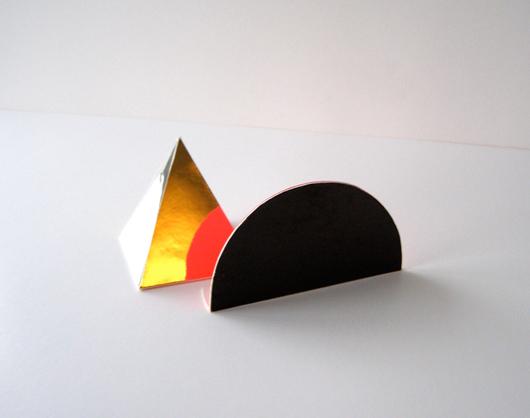
Examples of his Color Research objects, created as studies for the Room Dividers
Oskar: I have to admire your drive in that sense — sometimes I think about things too much, whereas you were always a bit more of a go-to-it type guy. What would you say would be your true calling?
Lukas: Having my own studio to make my own work, but also be commissioned to make work for other people — diverse work, from public spaces to products to maybe some sort of graphic work. The more types of creative work I could do the better it would be. I’d like to experiment more with film and videos.
Oskar: Do you think Rudi really wanted us to become jewelers?
Lukas: I don’t think so, because I think he actually wants to do what we do. He’s definitely happy and likes what he does, but I think he’d also like to be able to get his hands into all different types of projects and different scales and materials, and I think he’s envious that we have the ability to do that. When he was our age he did more diverse things, with sculpture, etc. But when we were born he had the pressure of having a family and having to feed them. And this is what he’s really good at. Maybe he tried all the other aspects and fields and this is what he’s best at.
Oskar: I admire that — he has a skill, something no one can do better than him, especially where he’s sitting in the world. And it’s comforting to know you’re really good at something and you can rely on that.
Lukas: He aspires to be the best at what he does, whereas when you have the umbrella title of designer, it’s not quite the same thing. Maybe in 20 or 30 years I’ll only be making lamps and you’ll only be making ceramics, you never know.
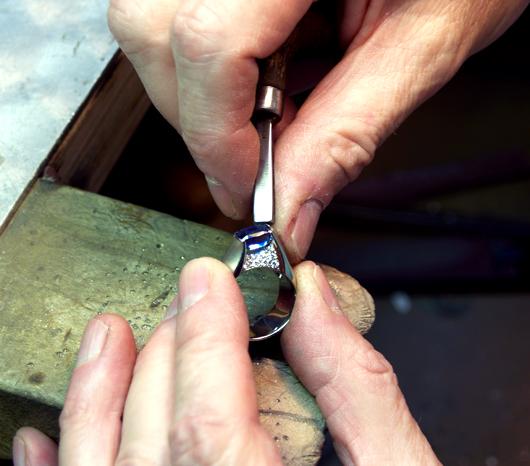
A photo of the Peets’ father Rudi, at work on one of his jewelry designs
